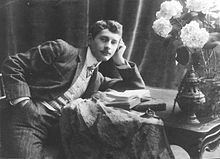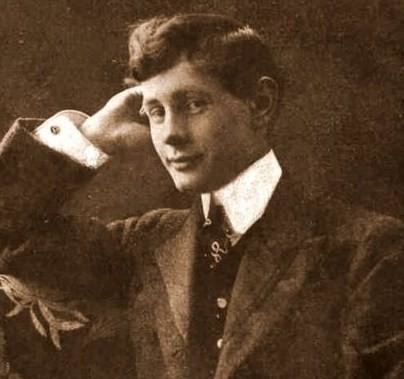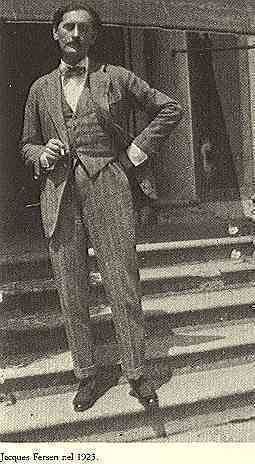Nationality French | ||
 | ||
Resting place Cimitero acattolico ("Non-Roman-Catholic cemetery"), Capri Died 5 November 1923, Capri, Italy Books Messes Noires- Lord Lyllian People also search for Nino Cesarini, R. P. Coppini, R. Nieri | ||
Baron Jacques d'Adelswärd-Fersen (20 February 1880 – 5 November 1923) was a French novelist and poet. His life forms the basis of a fictionalised biography by Roger Peyrefitte.
Contents

In 1903 a scandal involving school pupils made him persona non grata in the salons of Paris, and dashed his marriage plans; after which he took up residence in Capri in self-imposed exile with his long-time lover, Nino Cesarini. He became a "character" on the island in the inter-war years, featuring in novels by Compton MacKenzie and others. His house, Villa Lysis, remains one of Capri's tourist attractions.

Early life

He was born in Paris, France as Jacques d'Adelswärd, on 20 February 1880. As he was related on his paternal side to Axel von Fersen, a Swedish count who had had a supposed relationship with Marie Antoinette, D'Adelswärd took on the name Fersen later in his life to advertise his link with his distant relative. D'Adelswärd's grandfather had founded the steel industry in Longwy-Briey. Adelsward went to school in Paris and studied briefly there at the Ecole des Sciences Politiques, and afterwards at the University of Geneva.
In 1897 he visited Capri and other parts of Italy with his mother.

The family steel furnaces had become profitable enough to make Jacques d'Adelswärd a rich and 'eligible' bachelor when he inherited at the age of 22.
Apart from joining the military, he traveled extensively and settled down as a writer. He published Chansons Légères (1900) and Hymnaire d'Adonis (1902) and other poems and novels.
In 1902 he holidayed in Venice, where he associated with the novelist Jean Lorrain. On his return to Paris he published his novel, Notre Dame des mers mortes.
The trial
In 1903 Adelsward and his friend, Hans de Warren, were rumored to be holding "entertainments" – tableaux vivants of pupils from the best Parisian schools – in his house at 18 Avenue de Friedland. They were arrested on charges of inciting minors to commit debauchery, and Fersen served a six-month prison sentence plus being fined 50 francs and losing civil rights for five years. The "entertainments" had been attended by the cream of Parisian society, a factor which may have induced the court to drop some charges.
On Capri
After his marriage plans were foiled, d'Adelswärd-Fersen remembered the island of Capri from his youth, and decided to build a house there. The island had already attracted other homosexual or bisexual visitors, such as Christian Wilhelm Allers, Somerset Maugham. E. F. Benson, Alfred Douglas, Robert Ross, Oscar Wilde, Friedrich Krupp, Norman Douglas, and Compton and Faith Mackenzie; and attracted many others during Adelsward's stay. He bought land at the top of a hill in the northeast of the island, close to where the Roman emperor Tiberius had built his Villa Jovis two millennia earlier. His house, initially called Gloriette, was eventually christened Villa Lysis (later sometimes referred to as Villa Fersen) in reference to Plato's Socratic dialogue Lysis discussing friendship (or, according to modern notions, homosexual love).
Villa Lysis is a notable building. Its style is described by some as "Liberty" but is not Liberty or Art Nouveau in the French manner but may perhaps be described as "Neoclassical decadent". The large garden is connected to the villa by steps leading to an Ionic portico. In the atrium a marble stairway with wrought-iron balustrade leads to the first floor, where there are bedrooms with panoramic terraces, and a dining room. The ground-floor sitting-room, decorated with blue majolica and white ceramic, overlooks the Gulf of Naples. In the basement there is a 'Chinese Room', in which opium was smoked.
Jacques d'Adelswärd-Fersen spent the rest of his life based in Capri, and died there in 1923 —allegedly by suicide achieved through drinking a cocktail of champagne and cocaine. His ashes are conserved in the non-Catholic cemetery of Capri. His lover, Nino Cesarini, returned to Rome.
Lord Lyllian
Lord Lyllian, published in 1905, is one of d'Adelswärd-Fersen's more important novels, satirizing the scandal around himself in Paris, with touches of the Oscar Wilde affair thrown in for good measure. The hero, Lord Lyllian, departs on a wild odyssey of sexual debauchery, is seduced by a character who seems awfully similar to Oscar Wilde, falls in love with girls and boys, and is finally killed by a boy. The public outcry about the supposed Black Masses is also caricatured. The work is an audacious mix of fact and fiction, including four characters that are alter egos of d'Adelswärd-Fersen himself.
Akademos revue
Akademos. Revue Mensuelle d'Art Libre et de Critique (1909) was d'Adelsward-Fersen's short-lived attempt at publishing a monthly literary journal. It was a periodical of a luxurious kind, each issue printed on several sorts of deluxe paper, with contributions by well-known authors, like Colette, Henry Gauthier-Villars, Laurent Tailhade, Josephin Peladan, Marcel Boulestin, Maxim Gorky, Georges Eekhoud, Achille Essebac, Claude Farrère, Anatole France, Filippo Tommaso Marinetti, Henri Barbusse, Jean Moréas and Arthur Symons.
In each issue, as is clear from Fersen's letters to Georges Eekhoud, a homosexual element was carefully introduced: a poem, an article, or a hint in the magazine's serial Les Fréquentations de Maurice by Boulestin. As a magazine with homosexual agenda it was the first of its kind in the French language, although only about 10% of Akademos may be counted as homosexual. In its 'gay' content it trod similar ground to that of the German journal, Der Eigene, published between 1896 and 1931 by Adolf Brand. This is not a coincidence, as d'Adelswärd-Fersen studied the German publications that tried to push for the social acceptance of homosexuality before launching Akademos. Also he corresponded with Brand and Magnus Hirschfeld.
Akademos lasted only one year—there were twelve monthly issues, amounting to some 2000 pages. Perhaps its production costs were too great; but in a letter to Eekhoud Fersen complained of the lack of interest of the press and the public; and a general hostility from press or society cannot be ruled out.
Film
Music
The lyrics of the song "Les Amants solitaires", by French soprano Nicole Renaud consists of four poems by Baron Fersen.
